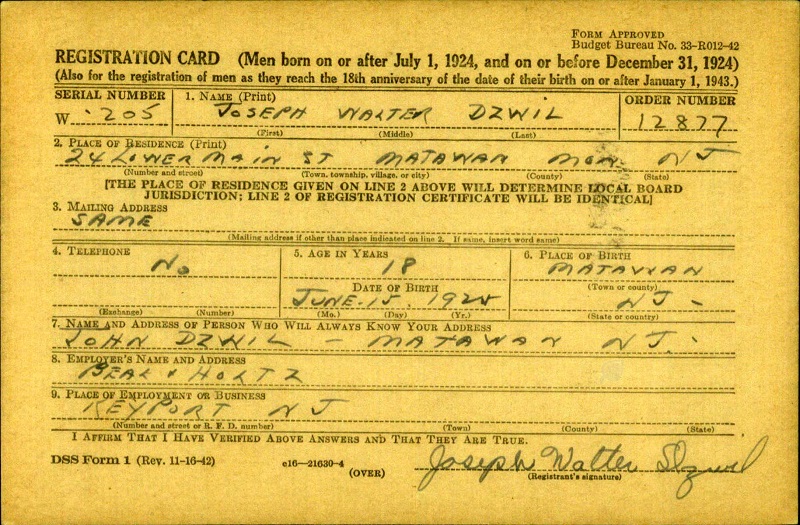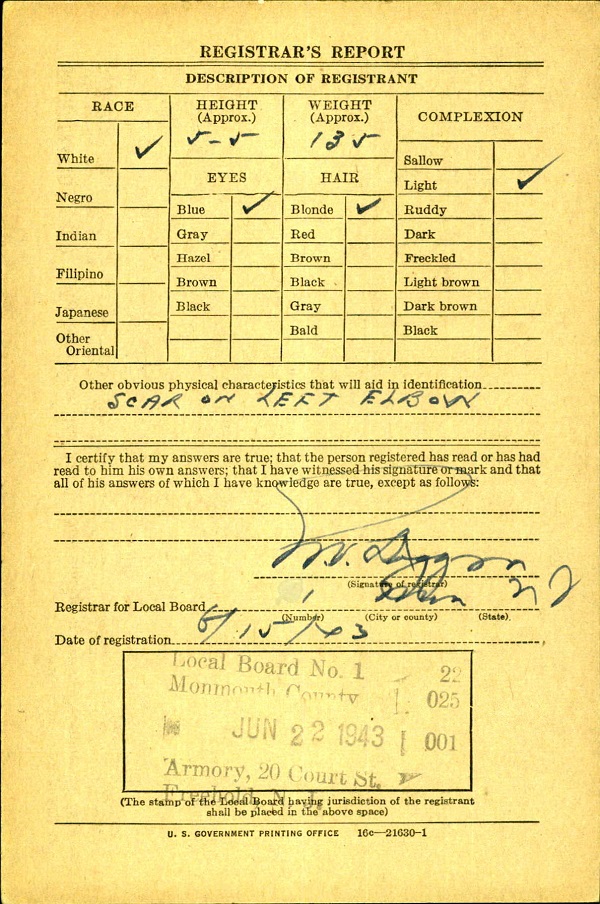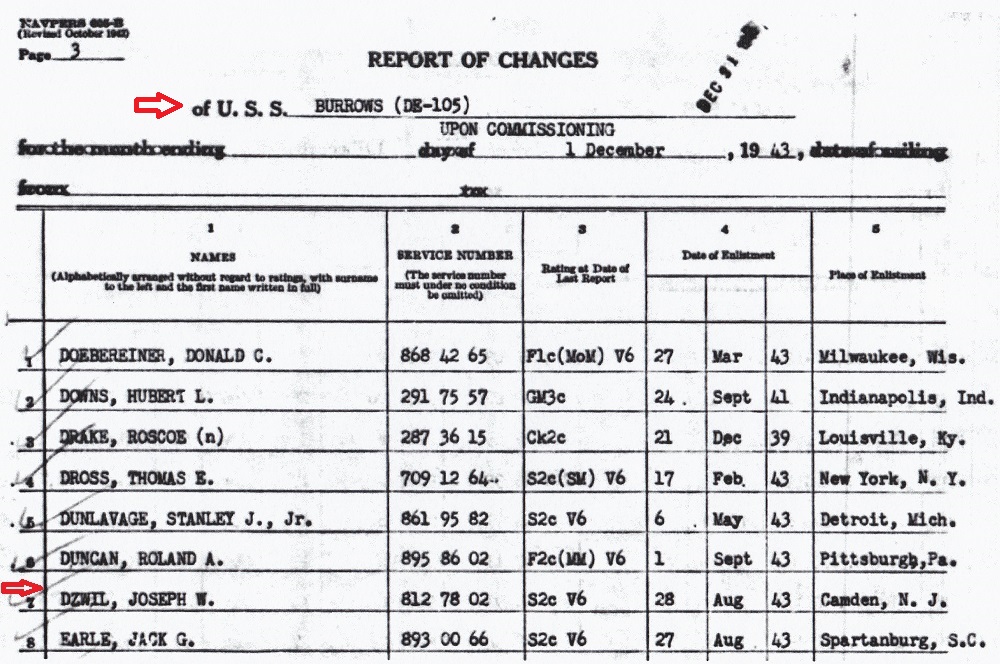Joseph W. Dzwil Military Records
World War II Draft Registration


Military Service Records


.jpg)
She was laid down at Wilmington, Delaware, on 24 March 1943 by the Dravo Corporation; launched on 2 October 1943; sponsored by Miss Ruth C. Tech; and commissioned on 19 December 1943 at the Philadelphia Navy Yard, Lt. Comdr. Robert W. Graham in command.
World War II North Atlantic operations
The destroyer escort left Philadelphia, Pennsylvania, on 30 December 1943 for shakedown training off Bermuda and returned to Philadelphia on 9 February 1944 for post-shakedown repairs before steaming to Norfolk, Virginia, for duty as a training ship for prospective destroyer escort crews. After less than three weeks, she received orders to New York City to await assignment to her first convoy.
On 27 February, the warship sailed for the first of 16 transatlantic crossings. In company with Marblehead, Milwaukee, four destroyers, and seven other destroyer escorts, Burrows sailed through the cold and stormy North Atlantic and arrived safely in Belfast, Northern Ireland. She proceeded to NOB Derry to join Escort Division 28 (CortDiv22); and, on 17 March, Burrows began her return voyage to New York. Upon arriving there on 28 March, she entered the navy yard for an overhaul.
Burrows' typical cycle for escort duty was to steam overseas, return to New York for overhaul, undergo brief refresher training, and then steam back to New York to join another convoy. She served in the screen of a convoy to England in April and, upon return to New York, she interrupted her convoy-escort routine to conduct experiments at Quonset Point, Rhode Island, with the Navy's FXR (foxer) gear, an underwater noise-making device that trailed behind ships as a defense against German acoustic torpedoes. Back in New York by early June, Burrows stood out of port on the 13th with her longest and largest convoy, more than a hundred ships bound for Bizerte, Tunisia. The voyage took the convoy through the Strait of Gibraltar, where reports of Luftwaffe attacks prompted Burrows and the other escorts to lay smoke screens twice daily over the ships. Although German bombers passed within two miles, they did not strike; and the convoy arrived on 1 July. Burrows sailed on 10 July for the United States.
Following overhaul, the warship steamed to Casco Bay, Maine, for extended training in torpedo evasion techniques. On 20 August, the destroyer escort got underway for New London, Connecticut, where she put this training to good use during service as a practice target for American submarines. For 34 days, dummy torpedoes passed under Burrows while prospective commanding officers and submarine crews sharpened their fighting skills.
Sailing her fourth convoy
Burrows departed New York again on 6 October with her fourth convoy. By this time, the German submarine strategy had changed. During her earlier trips, the U-boats were attacked principally in the western and middle Atlantic. Later in the war, as the German effort faltered and the Allies invaded Europe, Dönitz moved his submarines closer to their home bases and concentrated operations in the mid-eastern Atlantic, the Irish Sea, and the English Channel. Burrows' convoy, however, encountered no German U-boats while steaming through the danger zone and arrived safely in Liverpool, England, on 17 October.
The destroyer escort made three more convoy trips before the end of March 1945. Once when she was only a few days out of New York on her seventh eastward crossing, high winds and heavy seas battered her convoy severely. Two of the convoy's merchant ships, SS Lone Jack and SS Frontenac Victory, collided. Burrows stood by the badly damaged ships for nine hours to render assistance, but the ships managed to stay afloat through the night. The night hours visited even more excitement on the warship after a fire broke out in the muffler spaces above her own machinery. Fortunately, her well-drilled damage control parties rapidly extinguished the flames before the ship suffered any serious damage.
Damaged in rough North Atlantic seas
In the morning, a westbound convoy appeared on the horizon, and two of its escorts relieved Burrows of her standby duties, enabling her to catch up to her own convoy by the next day. The remainder of the trip passed without incident, and the ships arrived in Liverpool on 11 March. Heavy weather again tormented Burrows' return convoy. On 23 March, a huge wave tore off her forward 3-inch gun shield, ripping two holes in the forecastle deck. In spite of the heavy pounding, Burrows maintained her station while accomplishing temporary repairs; and, on 25 March, she steamed into the safety of New York harbor.
Joe served on the Burrows from December of 1943 until the escort ship arrived back in New York harbor on March 25, 1945. A timely occasion for Joe who was released from active duty the next day. Burrows departed New York on 16 April with her eighth and last eastbound convoy. The crossing was easy; and — after dropping one part of the convoy in Weymouth, England, and delivering the rest to Le Havre, France — Burrows returned to Southampton to prepare for her return voyage. On 8 May, while she transited the Atlantic, hostilities with Germany ended.
During her 16 transatlantic trips, Burrows had escorted over 500 ships without having one of her convoys suffer a single loss from enemy action.